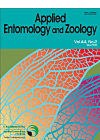Volume 37, Issue 2
Displaying 1-18 of 18 articles from this issue
- |<
- <
- 1
- >
- >|
Regular Papers
-
Article type: Regular Paper
Subject area: [not specified]
2002 Volume 37 Issue 2 Pages 225-232
Published: 2002
Released on J-STAGE: April 25, 2003
Download PDF (152K) -
Article type: Regular Paper
Subject area: [not specified]
2002 Volume 37 Issue 2 Pages 233-235
Published: 2002
Released on J-STAGE: April 25, 2003
Download PDF (37K) -
Article type: Regular Paper
Subject area: [not specified]
2002 Volume 37 Issue 2 Pages 237-249
Published: 2002
Released on J-STAGE: April 25, 2003
Download PDF (758K) -
Article type: Regular Paper
Subject area: [not specified]
2002 Volume 37 Issue 2 Pages 251-255
Published: 2002
Released on J-STAGE: April 25, 2003
Download PDF (221K) -
Article type: Regular Paper
Subject area: [not specified]
2002 Volume 37 Issue 2 Pages 257-262
Published: 2002
Released on J-STAGE: April 25, 2003
Download PDF (70K) -
Article type: Regular Paper
Subject area: [not specified]
2002 Volume 37 Issue 2 Pages 263-269
Published: 2002
Released on J-STAGE: April 25, 2003
Download PDF (104K) -
Article type: Regular Paper
Subject area: [not specified]
2002 Volume 37 Issue 2 Pages 271-277
Published: 2002
Released on J-STAGE: April 25, 2003
Download PDF (75K) -
Article type: Regular Paper
Subject area: [not specified]
2002 Volume 37 Issue 2 Pages 279-283
Published: 2002
Released on J-STAGE: April 25, 2003
Download PDF (85K) -
Article type: Regular Paper
Subject area: [not specified]
2002 Volume 37 Issue 2 Pages 285-289
Published: 2002
Released on J-STAGE: April 25, 2003
Download PDF (55K) -
Article type: Regular Paper
Subject area: [not specified]
2002 Volume 37 Issue 2 Pages 291-294
Published: 2002
Released on J-STAGE: April 25, 2003
Download PDF (85K) -
Article type: Regular Paper
Subject area: [not specified]
2002 Volume 37 Issue 2 Pages 295-298
Published: 2002
Released on J-STAGE: April 25, 2003
Download PDF (88K) -
Article type: Regular Paper
Subject area: [not specified]
2002 Volume 37 Issue 2 Pages 299-304
Published: 2002
Released on J-STAGE: April 25, 2003
Download PDF (69K) -
Article type: Regular Paper
Subject area: [not specified]
2002 Volume 37 Issue 2 Pages 305-308
Published: 2002
Released on J-STAGE: April 25, 2003
Download PDF (39K) -
Article type: Regular Paper
Subject area: [not specified]
2002 Volume 37 Issue 2 Pages 309-312
Published: 2002
Released on J-STAGE: April 25, 2003
Download PDF (42K) -
Article type: Regular Paper
Subject area: [not specified]
2002 Volume 37 Issue 2 Pages 313-318
Published: 2002
Released on J-STAGE: April 25, 2003
Download PDF (61K) -
Article type: Regular Paper
Subject area: [not specified]
2002 Volume 37 Issue 2 Pages 319-322
Published: 2002
Released on J-STAGE: April 25, 2003
Download PDF (60K) -
Article type: Regular Paper
Subject area: [not specified]
2002 Volume 37 Issue 2 Pages 323-328
Published: 2002
Released on J-STAGE: April 25, 2003
Download PDF (303K) -
Article type: Regular Paper
Subject area: [not specified]
2002 Volume 37 Issue 2 Pages 329-333
Published: 2002
Released on J-STAGE: April 25, 2003
Download PDF (107K)
- |<
- <
- 1
- >
- >|
